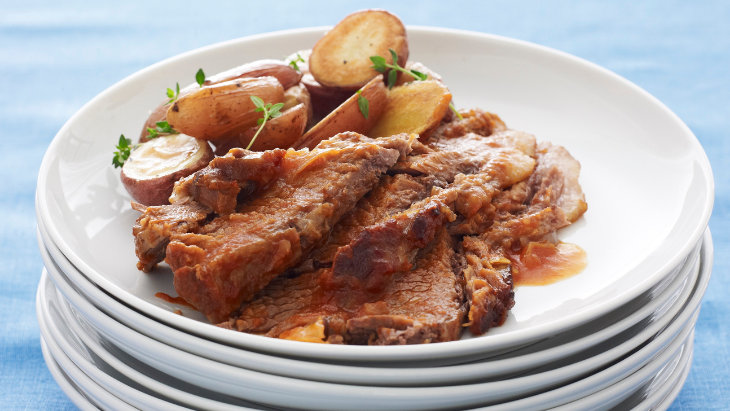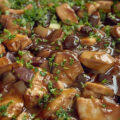The story of brisket is a love story between American and Jewish cultures. So let's get to the meat of how it became every Jew's favorite cut of beef.
Straight Outta Texas?
Brisket is one of those foods everyone must try at least once. It can be found in nearly every smokehouse in the South and Midwest, as well as on many Shabbat tables around the country.
While many claim that brisket was first invented in Central Texas, its origins can be traced back to the 1600’s, when it was an Eastern European delicacy traditionally eaten on Rosh Hashanah and Passover.
To truly understand how brisket became ubiquitous in Jewish cuisine, we need to dig into the delicious history of brisket.
Risk it for the Brisket
Many scholars believe that the word "brisket" comes from the Middle English phrase "brusket,” which finds its origins in the even more prehistoric Old Norse "brjósk," meaning cartilage. Due to the brisket’s placement on the cow.
One of the requirements of Kosher food is that the hind quarter of the cow isn't Kosher unless the sciatic nerve is removed, which is a process rarely done by butchers. This meant that Jews were left with only the forequarter of the cow (including brisket) to eat during festivals and celebrations. Brisket's large cut makes it an unrealistic everyday meat, so eating brisket was always saved for special occasions.
Brisket is also connected to Rosh Hashanah - the Jewish New Year. In the Torah, on Rosh Hashanah, we see Ezra, the priest leading Israel at the time, command the Jewish people to: "Go eat succulent meats and drink sweet beverages and send portions to whoever has nothing prepared, for the day is holy to our Lord, and do not be sad, for the joy of the Lord is your strength.”
Many in the Old Country took this commandment literally, and went out to buy the fattiest cut of meat they could get their hands on for the holiday. In addition to its practical viability, Jews in Eastern Europe preferred their meat “Gedempte Fleysch” - which in Yiddish means well-stewed. Slow cooking allowed the meat to become tender and delicious, which is the perfect way to cook brisket.
All these cultural and religious factors contributed to brisket’s popularity among Eastern European Jewry and its later acclaim in the States.
The First American Barbecue
Barbecue is one of the United State's greatest claims to culinary fame, and brisket plays no small part in that story.
The first barbecue took place many years ago, when our distant ancestors began cooking animal meat over a fire. But the barbecues we know now, meat covered in spices and rubs cooked over a grill or pit, originated in the Caribbean.
It is said that on his journey to the Americas, the first native tribes that Christopher Columbus encountered had developed a distinctive method for cooking meat. By using green wood, they were able to prevent the meat and the wood from burning. Columbus and his companions referred to this new method of cooking as barbacoa—the original BBQ.
Columbus took his newfound knowledge, riches, and cooking methods back to Spain, where it spread all over Europe. Eventually, the technique made its way to the American colonies, even traveling as far north as Virginia. All of this helped to pave the way in Eastern Europe, and later in America, for our favorite stewed meat.
From the Shtiblach to the Smoker
During the 19th-century waves of immigration to the U.S., many Czech and German Jews found their way to Texas. The immigrants and locals began swapping recipes and cooking methods.
Brisket gained popularity out of necessity. At the time, brisket was plentiful, and the ranchers and immigrants couldn't afford the more expensive tender cuts. So, they were stuck with the tough meat that nobody else wanted.
"Brisket is implicitly kosher since it's from the front of the animal," says New York Times reporter Julia Moskin, "and it was cheap because anything that takes a long time to cook and that can't be grilled has challenges, especially in a restaurant."
In the mid-1950's, smoked brisket found itself on menus in nearly all the Jewish delis. It eventually started to take off and gain attention from some of the top-tier smokehouses in the BBQ capital of the world, Texas.
That was all it took, and soon enough brisket was being eaten all across Texas, and ultimately the entire country, with each region preparing the cut slightly differently.
One Man's Trash
The story of brisket is one with its hands in many different cultural pies, from the early days of the Americas, to Texas ranchers and farmers and Jewish immigrants. Brisket went from a poor man's fatty and tough cut of meat, to becoming one of the most prized (and pricey) cuts at the butcher for its succulent taste when smoked or braised - sometimes costing upwards of $40 a pound these days.
This goes to show the evolution of our culture and cuisine, and how one man's trash is another's treasure. By turning our adversity and dietary limits into strengths, we were able to create a timeless meal that Jews have enjoyed for centuries.
Get our recipe for The Best Jewish Brisket and bring home a little bit of history.















